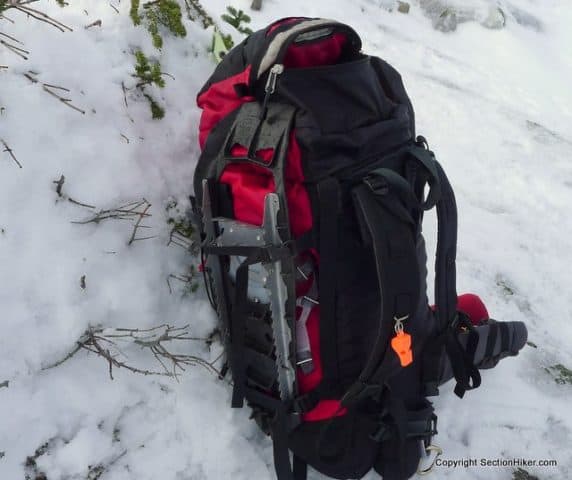The MSR Evo Ascent is a bomber snowshoe that excels in mountainous terrain both on trail and off. Its unibody plastic decking makes it extremely rugged with aggressive crampons for purchase on snow, ice, and rock. It has a snowshoe binding that is compatible with any kind of footwear and folds flat when strapped to the sides of a backpack, making them very easy to carry if your pack has side compression straps. A rear heel bar is also included to reduce calf fatigue when climbing hills, while optional 6″ tails can be added to the rear if you need more flotation for heavier loads or snowshoeing in deeper powder.
Specs at a glance
- Gender: Unisex
- Weight: 3 lbs 15 oz per pair
- Length: 22″
- Sizing: Fits boots up to size 15 (US) Men’s
- Decking: Plastic unibody
- Binding: MSR TriFit
- Heel Bars: Yes
I’ve been using MSR Evo Ascent Snowshoes for climbing mountains in winter, both on trail and off, for well over 10 years. While I have also used most of MSR’s other snowshoes, including the top-of-the-line MSR Lightning Ascent, I prefer the Evo Ascent because it’s so durable, packable, and a great climber, particularly in conditions where traction is more important than flotation, such as those in New Hampshire and Maine. While it snows here, the mountain maritime climate produces wetter, crustier snow and ice and much less powder than the drier conditions out west. While the Evo Ascents are only available in a 22″ length, they still work quite well for large individuals and heavier loads up to 225-250lbs in such conditions, despite MSR’s weight recommendations which are more tuned to West Coast conditions.

Evo Ascent TriFit Binding
The Evo Ascent uses MSR’s classic TriFit binding with three top straps and one heel strap to hold your footwear in place. The straps are perforated and held in place by a pin at one end while the slack is held in place by plastic clips that prevent the ends from flapping annoyingly or coming undone. The advantage of this style of binding is that is it compatible with all types of footwear, sizes up to 15M (US) and you can fine-tune the fit if parts of your foot are sensitive to downward pressure.

The latest Evo Ascent model has been slightly overhauled to make the TriFit binding easier to use and ensure correct foot positioning. The TriFit binding now comes with softer, more malleable straps that have more stretch and pop open less frequently than in previous models. That is a very welcome change and it may be worth upgrading an older pair of Evo Ascents to take advantage of it. The new foot plate at the bottom of the binding also indicates where the ball of your foot should be placed when you put on the snowshoes so that your boots are not too forward or too far back. This is a very useful feature, particularly for new users.

One of the key advantages of the TriFit binding is that it folds flat when the Evo Ascent snowshoes are strapped to the outside of a backpack making them much easier to carry. Try that with a snowshoe with a bulky Boa binding like the Tubbs Flex VRT and you’ll quickly see the advantage of a lower profile binding if you need to carry snowshoes on a long-ass hike because you don’t know what snow conditions will be like en route to your destination.

Traction
The Evo Ascent has two types of traction: an aggressive front crampon that penetrates packed snow and ice and long side rails that provide lateral stability when transmitting sideways across slopes. A rear heel bar, or “televator” can also be raised so it rests under your heel to relieve calf strain. Doing so helps increase the bite of the front crampon when climbing slopes by transferring more of your body weight forward. The result is far more comfortable when climbing steep slopes than snowshoes that do not have this feature and are intended for use in flatter terrain.

Braking fins are also molded to the underside of the decking that dig into the snow and help prevent sliding or fishtailing when descending slippery slopes. In very icy conditions where the frame brakes can’t bite into the surface, it’s best to lean forward on the front crampon to get a deeper bite or to angle the snowshoes across the slope so that the serrated side rails can provide additional traction.

Decking
The Evo Ascent snowshoes have plastic unibody decking that is quite stiff and durable with built-in fins that act like brakes when descending slopes. The unibody decking comes in very handy when hiking off-trail because there is no way for a tree branch to get stuck between the decking and frame, which can be an issue in the MSR Lightning Ascent and similar snowshoes if you try to hike off-trail using them. Being rigid, the unibody decking is also great for rock-hopping across streams or across mixed rock and ice because the snowshoe deck won’t buckle underneath you when it has to span open space.

Comparable Winter Hiking Snowshoes
Recommendation
MSR’s Evo Ascent Snowshoes are rugged snowshoes that excel in challenging winter conditions and mountainous terrain, both on trail and off. Fully featured they have aggressive crampons, heel bars for climbing, and a highly durable unibody decking that can withstand tremendous abuse and keep on ticking. Now easier to use than ever, they’re a good investment that will provide years of use with little maintenance. Perhaps best of all is their price, which is significantly less than most other mountaineering-class snowshoes without skimping on features, ease of use, or durability.
SectionHiker is reader-supported. We only make money if you purchase a product through our affiliate links. Help us continue to test and write unsponsored and independent gear reviews, beginner FAQs, and free hiking guides.
Disclosure: The author owns these snowshoes.
